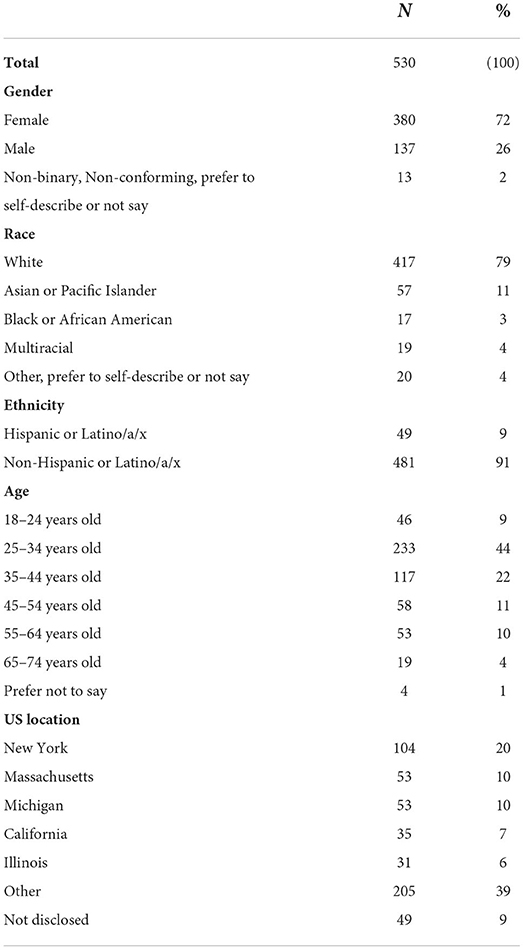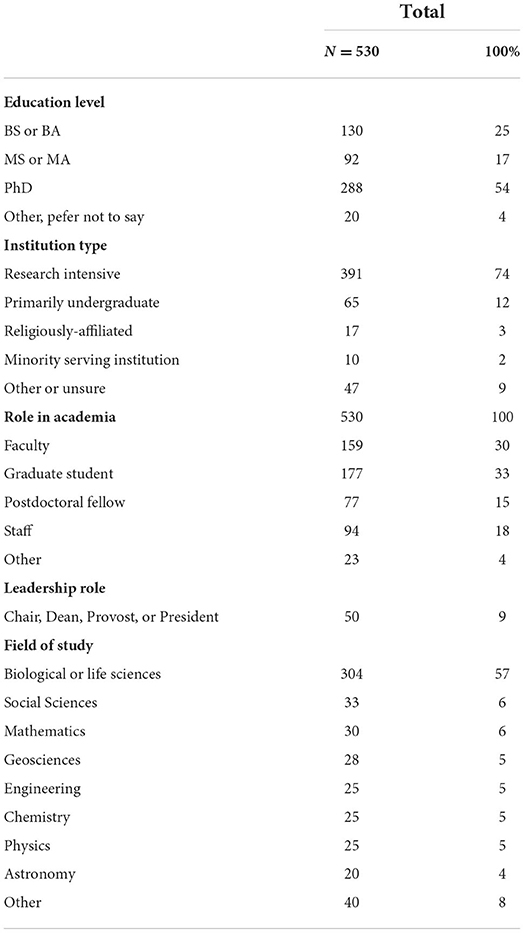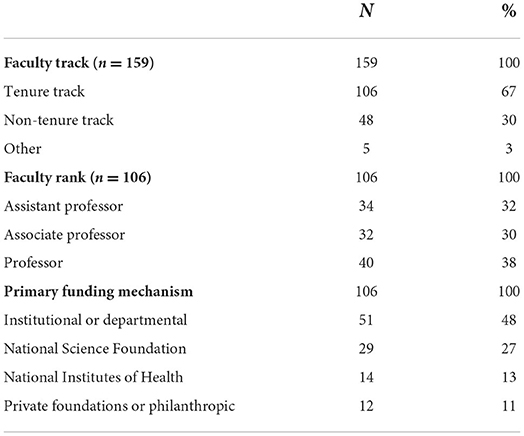- 1Department of Medical Social Sciences, Feinberg School of Medicine, Northwestern University, Chicago, IL, United States
- 2American Society for Microbiology, Washington, DC, United States
- 3Division of Biostatistics, Department of Preventive Medicine, Feinberg School of Medicine, Northwestern University, Chicago, IL, United States
- 4RockEDU Science Outreach, The Rockefeller University, New York, NY, United States
The practice of science outreach is more necessary than ever. However, a disconnect exists between the stated goals for science outreach and its actual impact. In order to examine one potential source of this disconnect, we undertook a survey-based study to explore whether barriers to participation (either intrinsic or extrinsic) in science outreach exist within the academic community. We received responses to our survey from 530 individuals, the vast majority of whom engage in some type of science outreach activity on an annual basis. Those who engage in outreach report doing so for both personal and altruistic reasons, and having high (yet varied) levels of comfort with performing outreach activities. Respondents also report the existence of several significant yet surmountable barriers to participation, including lack of time and funding. Our findings demonstrate that both levels of participation in, and attitudes toward, science outreach within the academic community are generally favorable, suggesting that the general ineffectiveness of science outreach is due to other causes. We place our findings within the context of the broader science outreach, science communication and public engagement literature. We make recommendations on how existing approaches and infrastructure can, and must, be changed in order to improve the practice.
Introduction
As with any global health emergency, gaining the trust and cooperation of global publics is key to an efficient and effective response. One way to build this trust and influence key behavioral changes in service of public health and safety is through science outreach, also known as public engagement with science (Chan et al., 2021; Bernheim, 2022). As a global society, we have all been witnesses to how effective science outreach and community education can help manage the harmful impacts of the COVID-19 pandemic (Bhatia, 2020; Gilmore et al., 2020; Caulfield et al., 2021). As we continue to learn about the impact of COVID-19 and the biology of the SARS-CoV-2 virus, we are also seeing a steady stream of accompanying misinformation that continues to challenge standard and experimental scientific processes, sowing mistrust and uncertainty in communities across the globe. For example, the COVID-19 pandemic revealed that many communities face incredible barriers to accessing important, evidence-based public health information, leading to vaccine skepticism and a refusal to adopt behaviors such as social distancing and masking. We believe this clearly demonstrates an urgent need for cogent, lucid dialogue between the scientific and medical communities and broader publics. Yet the foundations upon which such engagements lie, such as trust, warmth and competence, are wobbly at best, leading to ineffective execution that has only furthered the divide between scientists and non-scientists (Fiske and Dupree, 2014). Before we as a scientific community can even begin to approach a cure, we must first diagnose the cause(s) of this disconnect.
Science outreach, as a general concept, is not new. Sometimes referred to as “science engagement” or “public engagement with science,” science outreach can be generally described as a framework that allows scientific communities from academic or institutional contexts to meaningfully connect with non-scientific communities around a collection of overlapping goals, which are met through the application of effective science communication and/or informal education practices, and are characterized by reciprocal learning for all involved (Lopes et al., 2018; Garbarino, 2020). From natural philosophy lectures during the Renaissance era to the advent of science museums in the early twentieth century to the use of social media channels in the twenty-first century, we have seen science outreach take many exciting, adaptable forms.
Unfortunately, within academia, science outreach has traditionally been perceived as a low-status task (The Wellcome Trust, 2006; Johnson et al., 2014) that is typically performed by graduate students and early-career faculty, the majority of whom are women (Andrews et al., 2005; The Wellcome Trust, 2006; Ecklund et al., 2012; Johnson et al., 2014). In addition, significant barriers to participating in outreach exist, such as limited time and disapproval from peers or supervisors (Andrews et al., 2005; The Wellcome Trust, 2006; Ecklund et al., 2012). We know from earlier work that institutions of science value research endeavors above all else, resulting in the marginalization of staff involved in science outreach efforts, as well as a scarcity of hard funding and infrastructure for such initiatives. Training for scientists wishing to contribute to these efforts is similarly lacking (Bevan et al., 2020). The pursuit of science outreach and engagement activities is also often frowned upon by many members of the scientific community, whether because these activities are considered peripheral, or because weighing in on a politically charged subject is deemed “too risky” (Canfield et al., 2020). This has many downstream impacts, touched upon above, which were (and still are) magnified during the COVID-19 pandemic. Science is not a neutral arbiter. Rather, science is entrenched in the social, ethical, and political values of the scientist who chooses how to conduct, apply, and/or disseminate research findings (Lacey, 1999). As such, science outreach also assists the scientist in learning the broader and more diverse belief systems held by members and groups within our society (Pardini et al., 2021).
With so many variables affecting the implementation and execution of science outreach initiatives, it has been challenging to identify the most pertinent issues that need addressing. Though several social science research groups are working to understand the science of science outreach, a broad understanding of this field and how it fits within an evolving scientific ecosystem is limited. Often, reports on science outreach are centered on highly contextual circumstances, such as examining the role of a specific engagement program on science identity. For example, Gall et al. have shown that in-school visits are more effective at reaching students from historically underrepresented backgrounds in science compared to a science fair type of outreach program (Gall et al., 2020). While studies of this nature offer specific insights, these efforts are not relevant in understanding how to scale and sustain effective science outreach efforts associated with academic scientists and the institutions within which they conduct their research. Moreover, few peer-reviewed studies have examined science outreach's relationship and utility to the scientific research enterprise. To date, only a small number of studies have focused on scientists' involvement with science outreach (Michelle et al., 2001; Andrews et al., 2005; Poliakoff and Webb, 2007; Ecklund et al., 2012; Johnson et al., 2014; Lisa and Russo, 2015). While informative, these studies have several limitations as they usually contain small sample sizes (Andrews et al., 2005; Poliakoff and Webb, 2007; Ecklund et al., 2012; Johnson et al., 2014), are not specific to the U.S. research enterprise (Michelle et al., 2001; The Wellcome Trust, 2006), or provide perspectives from a single scientific field (Lisa and Russo, 2015).
Seemingly in conflict with how little we know in terms of scaling science outreach within the scientific enterprise, agencies funding scientific research, such as the National Science Foundation (NSF), continue to require “broader impacts” statements (often manifested as science outreach initiatives) for awarding grant monies. However, it is not clear if this mandate for funding has had any collective impact—positive or negative—on the relationship between science and society. Additionally, we know that scientists are motivated by emotions like joy, wonder, and curiosity, as well as the desire to “do good” for society, which are all intrinsic motivations that connect with how general public's view science and scientists (Johnson and Dieckmann, 2020; Funk and Hefferon, 2022).
As the nexus of science and society continues to mandate a shift in favor of science outreach and the practices of science communication and engagement, we must continue to explore the tensions that arise between academic science and these activities. Here, we contribute to the growing social science research surrounding the profession and practice of science outreach in order to better understand how the perceptions and motivations for participation in these activities has—or has not—shifted among academic STEM trainees and professionals. These data, in combination with existing findings, can help establish a baseline understanding of this rapidly growing field, which is an essential exercise if we are to sustain, or even expand, these efforts in ways that make genuine impact on our society.
Methods
A survey instrument designed to assess scientists' attitudes toward science outreach and motivations or barriers to participation was developed through a collaborative consensus process and use of the instrument was piloted by a convenience sample of colleagues engaged in science outreach at varying levels of frequency. Based on the feedback from the pilot study, the survey instrument was further revised for clarity. Survey themes included demographics, academic institution type and role, participation in science outreach, attitudes toward outreach, and career information for science outreach professionals. The full survey instrument can be found in Supplementary material 1. A snowball sampling strategy was utilized to distribute the survey (Qualtrics, www.qualtrics.com) between January 10th, 2020 and April 17th, 2020. Briefly, two of the authors (NCW and JG) shared an invitation to participate in the survey with their professional networks through email and social media platforms. The survey invitation encouraged participants to share the email or post within their professional networks as well. Participants were not compensated for their participation in this study. Subsequently, the survey link received 1,796 unique clicks and was primarily accessed through email (72%), Twitter (32%), and other social media platforms (6%). Inclusion criteria included graduate students, postdoctoral fellows, faculty, and staff at academic institutions within the United States who self-identified as belonging to a science, technology, engineering, or mathematics discipline. Two gating questions, “Do you study or work in a science, technology, engineering or math (STEM) field?,” and “Do you study or work at a 2- or 4-year college, university, or academic research institution within the United States?” were used to screen participants for the inclusion criteria. Incomplete survey responses were excluded from the final dataset of 530 respondents, for a relative response rate of 30% based on unique survey link clicks.
Quantitative data analyses
Demographics and survey respondents' academic roles were summarized using frequencies and percentages. Categorical survey responses were reported using percentages. Median, mean, and standard error of the mean were computed for ordinal survey responses. Chi-square tests were used to compare participation in science outreach activities by academic role, academic rank, and gender. Differences in ordinal responses to questions related to comfort in science outreach participation were assessed using Kruskal-Wallis tests.
Qualitative data analyses
Open ended survey comments were analyzed using a thematic approach. Two of the authors (NCW and JG) independently read and manually coded participant comments using deductive methods. Comments related to the statement, “I participate in science outreach because…” were assigned one of more of the following categories: Personal motivations; diversity, equity, inclusion and access; promoting education; societal relevance; inspiring the next generation; or other. Comments related to the statement, “I do not participate in science outreach because...” were assigned to one or more of the following categories: Time constraints; lack of professional incentive; unsure of opportunities; or other. Two of the authors (NCW and JG) discussed the comments to agreement.
The Rockefeller University institutional review board deemed this study exempt from further review. P-values < 0.05 were considered significant.
Results
Characteristics of survey respondents
A survey instrument designed to assess scientists' attitudes toward science outreach and identify motivations or barriers to participation in science outreach is described in detail in the Methods section. A total of 530 respondents completed the survey representing a range of scientific disciplines, career stages, and academic institutions. The majority of respondents were white (79%, n = 416), women (72%, n = 380), between the ages of 24–44 (66%, n = 350) (Table 1). Respondents most frequently reported studying or working in New York (20%, n = 104), Michigan (10%, n = 53), Massachusetts (10%, n = 53), California (7%, n = 35), and Illinois (6%, n = 31).
Next, respondents were asked to describe their educational background, academic role and institution type (Table 2). The majority of respondents hailed from the biological sciences (57%, n = 304) and had earned a PhD in their respective STEM discipline (54%, n = 288). Respondents held varying roles in academia such as faculty (30%, n = 159), graduate students (33%, n = 177), postdoctoral fellows (15%, n = 77), and staff/other (22%, n = 117), and worked or studied at a research-intensive institution (74%, n = 391). Fifty respondents (9%) indicated that they held a leadership role such as a Department Chair, Dean, Provost, or President. Of the faculty respondents (n = 159), 67% held tenure track positions at the rank of assistant (32%, n = 34), associate (30%, n = 32), and full (38%, n = 40) professor (Table 3). Faculty respondents reported that their research was primarily supported by institutional or departmental funds (48%, n = 51) and National Science Foundation (27%, n = 29) or National Institutes of Health (13%, n = 14) grants (Table 3).
Respondent participation in science outreach
First, respondents indicated how often they participate in science outreach activities with varying degrees of frequency (Figure 1). In this survey, science outreach was defined as activities which, “broadly represent the different types of interactions between scientists and non-scientists…[sometimes] referred to as public engagement with science, informal science education, or science communication.” Frequency was defined by the following criteria: Never (I do not participate in science outreach). Rarely (1–2 times/year), Sometimes (2–3 times/year), Often (6+ times per year), Always (It is part of my job description / I consider myself a science outreach professional). The frequency of which respondents participated in outreach significantly differed by their role in academia [X2 (12, n = 530) = 97.26, p < 0.0001]. Fifty percent of staff members engage in outreach “Always,” or “Often,” compared to 40% of graduate respondents, 38% of faculty, and 17% of postdoctoral fellows. Postdoctoral fellows comprised the largest group (58%, n = 45) of respondents who “Rarely” or “Never” participate in science outreach (n = 42; Figure 1B). The frequency of faculty participation in science outreach did not differ by tenure track status [X2 (2, n = 159) = 1.52, p = 0.465; Figure 1C] or rank [X2 (2, n = 106) = 5.96, p = 0.202; Figure 1D]. However, frequency of participation in science outreach varied by gender [X2 (2, n = 517) = 8.63, p = 0.013], as men were more likely to report that they did not participate in outreach, or did so rarely (45%, n = 62) compared to women (31%, n = 119, Figure 1E).
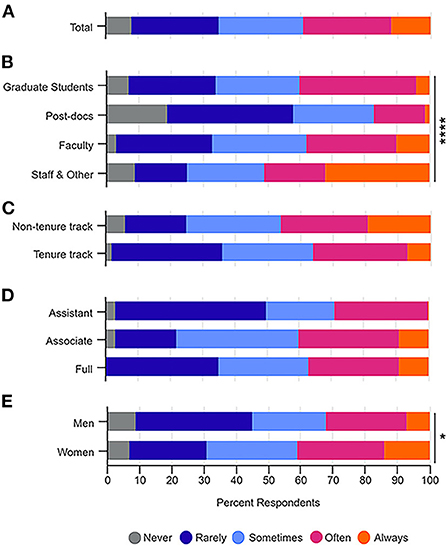
Figure 1. Comparison of respondents' participation in science outreach activities. (A) The majority of respondents (65%, n = 344) participate in science outreach at least 3 or more times per year. (B) Participation in science outreach varies by academic role [X2 (12, n = 530) = 97.26, p < 0.0001]. (C) There were no differences in participation based on faculty track [X2 (2, n = 159) = 1.52, p = 0.465] or (D) faculty rank [X2 (2, n = 106) = 5.96, p = 0.202]. (E) Participation in science outreach differs by gender [X2 (2, n = 517) = 8.63, p = 0.013]. *p ≤ 00.05; ****p ≤ 0.0001.
Types of outreach and engagement
When asked about the types of science outreach activities that they participate in, the majority of respondents indicated that they engage with a K-12 student population (59%, n = 305) or participate in public talks or lectures (54%, n = 278) (Figure 2A). In addition, many respondents also engaged in science outreach activities on social media (49%, n = 251) or at science fairs (41%, n = 214). Twenty-five percent of respondents (n = 133) indicated that they have received some type of formal training in science outreach. Of the 75% of respondents who have not received any training (n = 397), 50% (n = 200) expressed an interest in doing so (Figure 2B).
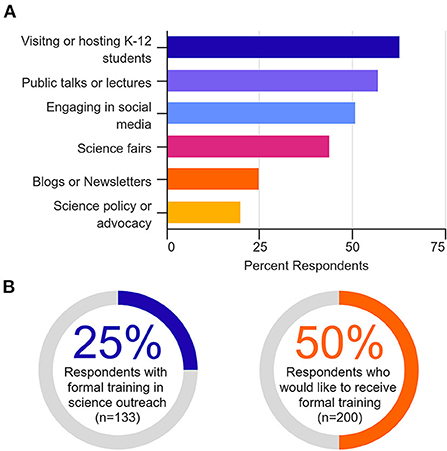
Figure 2. Respondents' exposure to outreach activities and training opportunities. (A) The percentage of respondents who engage in various science outreach activities. (B) The percentage of respondents who have received or are interested in receiving formalized training in science outreach.
Comfort participating in science outreach
Respondents were asked how comfortable they would currently feel participating in a science outreach activity on a 10-point scale (1 being not comfortable at all, 10 being very comfortable) (Figure 3). The median response was fairly high [Median (Mdn) = 9, Mean (M) = 8.3 Standard Error of the Mean (SEM) = 0.09]. There was a significant difference in reported comfort levels among the various roles and ranks within academia [H = 21.27, p = 0.0003, n = 530)] with faculty reporting the highest comfort levels (Mdn = 9, M = 8.8 SEM = 0.13) compared to postdocs who reported the lowest comfort levels (Mdn = 8, M = 7.67 SEM = 0.30; Figure 3A). There were significant differences in comfort levels based on respondents' frequency participating in science outreach [H = 137.5, p < 0.0001, n = 530], with increased comfort levels corresponding to greater frequency of participation (Figure 3B). Those who did not participate in outreach had the lowest response in their comfort with outreach (Mdn = 6.5, M = 5.9 SEM=0.39) compared to those who always participated in outreach (Mdn = 10, M = 9.48 SEM = 0.11). Respondent age was also a significant factor for who participates in outreach [H = 15.1, p = 0.019, n = 530)], with those between the ages of 45-54 years old reporting the greatest comfort levels (Mdn = 10, M = 9.0 SEM = 0.17; Figure 3C). There were no differences in comfort level in outreach participation based on gender [H = 8.41, p = 0.07, n = 517; Figure 3D].
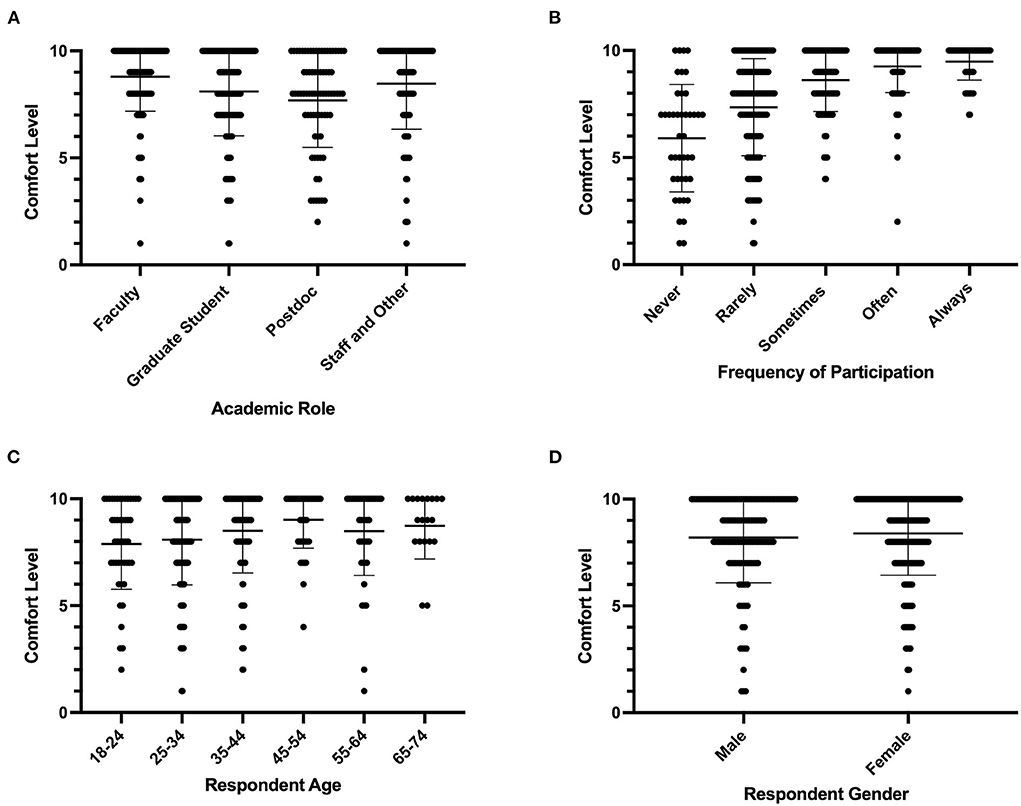
Figure 3. Comparison of respondents' comfort level participating in science outreach activities. Respondents comfort level (1 – not being comfortable at all to 10 – being very comfortable) participating in science outreach significantly differed by (A) academic role [H = 21.27, p = 0.0003, n = 530)], (B) how often they participate in outreach levels [H = 137.5, p < 0.0001, n = 530], and by (C) age [H = 15.1, p = 0.019, n = 530]. (D) Respondents' comfort level participating in outreach did not differ by gender [H = 8.41, p = 0.07, n = 517].
Perceived utility of science outreach
Next, respondents were asked to select their level of agreement with statements pertaining to the utility of science outreach at the level of both the individual scientist and academic institution (Figure 4). The majority of respondents agreed that science outreach is a tool to establish relationships with their community (94%, n = 498), establish interest in STEM careers (93%, n = 492), and to educate or inform non-scientists about research findings (86%, n = 455). The majority also agreed that science outreach was a tool for scientists to build transferable skills (67%, n = 355). Only a minority of respondents agreed that science outreach was a tool to obtain research funding (34%, n = 180). The majority of respondents also agreed that science outreach was a tool for academic institutions to establish relationships with their community (92%, n = 486), create interest in STEM careers (92%, n = 486), and educate or inform non-scientists about research findings (84%, n = 443). The majority agreed that science outreach is a tool for academic institutions to address issues pertaining to diversity, equity, and inclusion (71%, n = 378) and to promote cultural competency (63%, n = 336). While 85% (n = 452) of respondents agreed that science outreach is a tool to recruit students, only a smaller proportion of respondents indicated that it was a tool to recruit faculty members (34%, n = 182). Lastly, the majority of respondents agreed that science outreach was a tool to attract philanthropic donors (67%, n = 355).
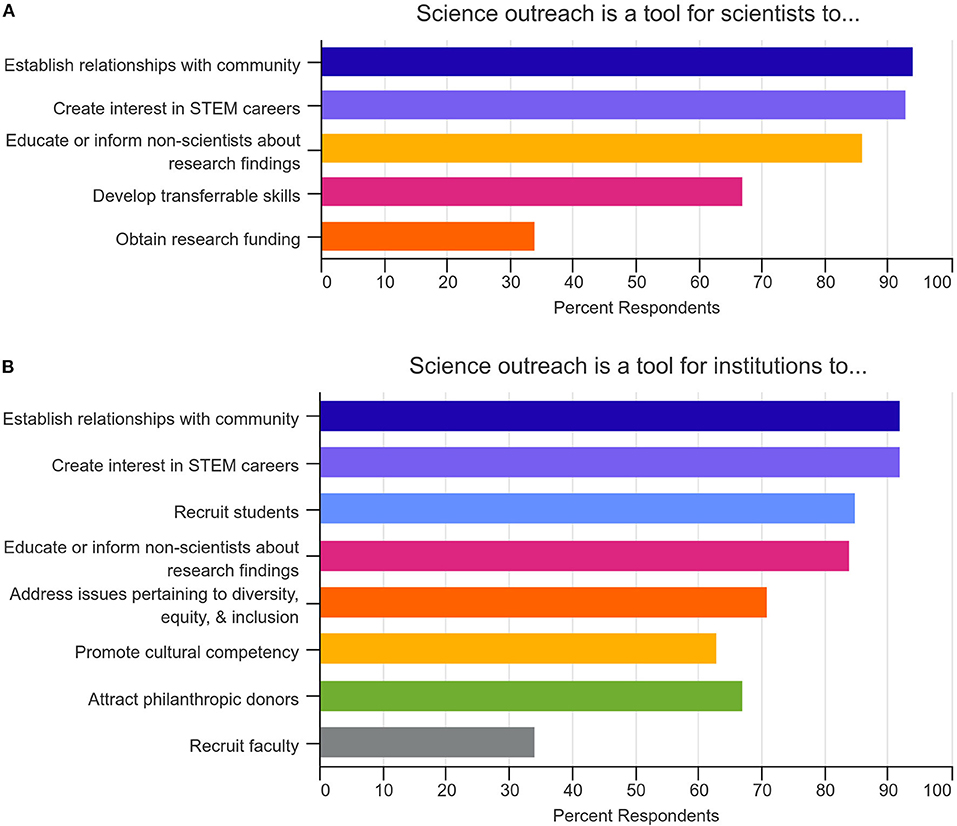
Figure 4. Respondents' attitudes toward the perceived utility of science outreach. (A) The percentage of respondents who agree that science outreach is tool for scientists to accomplish various tasks or initiatives. (B) The percentage of respondents who agree that science outreach is a tool for academic institutions to accomplish various tasks or initiatives.
Motivations and barriers to participation in science outreach
Respondents who indicated that they participated in science outreach with some level of frequency (either Rarely, Sometimes, Often or Always, n = 488) were asked a series of questions surrounding their personal motivations to engage in outreach (Figure 5). Over 90% respondents indicated that they participate in science outreach because it is fun and enjoyable (92%, n = 448). They also indicated that they participated in outreach to improve diversity, equity, inclusion, and access to STEM fields (91%, n = 444) or to serve as a role model or mentor (86%, n = 422). In addition, many respondents indicated that they participate in outreach to enhance their professional development (71%, n = 345). Less than a quarter of respondents noted that grant funding requirements were a factor in their decision to participate in science outreach (23%, n = 114).
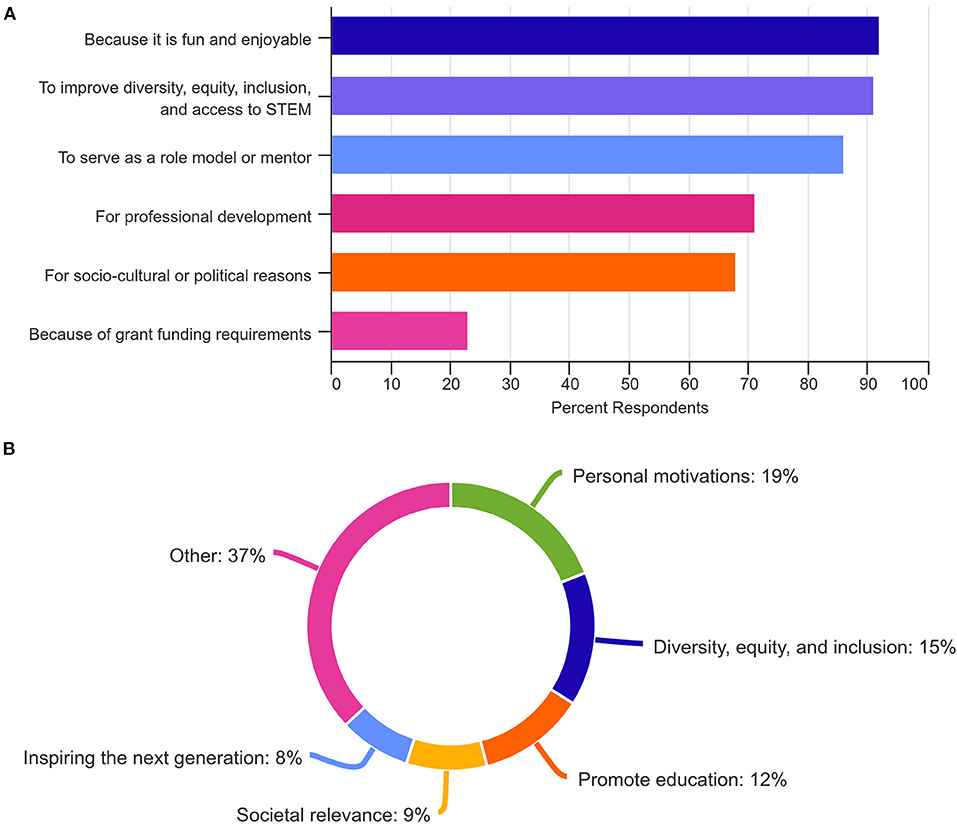
Figure 5. Respondents' motivations for participating in science outreach. (A) Percentage of respondents (n = 488) who indicated that they participate in science outreach for various reasons. (B) Percentage of codes (n = 388) associated with respondents' qualitative responses to the question, “I participate in science outreach because…”.
Respondents had the option to complete the following free-response statement: “I participate in science outreach because…” Three-hundred and thirteen statements were independently reviewed and coded by two of the authors (NCW and JG) and discussed to agreement. Fifteen codes emerged, with a total of 388 occurrences. The proportion of codes assigned were: Personal motivations (20%, n = 77), diversity, equity, inclusion and access (DEIA, 16%, n = 62), promoting education (12%, n = 48), societal relevance (10%, n=38), and inspiring the next generation (8%, n = 32; Figure 5B). Respondents' personal motivations focused on the direct benefit to the individual. For example, respondents indicated that they participate in science outreach because, “I value the experience and interactions…,” or “It gives my life meaning!” Other comments focused on the importance of improving diversity, equity, inclusion, and access to STEM fields. One respondent shared, “I believe it is essential in breaking down structures of privilege that influence who enters academia and sees themselves in science or not.” Another respondent noted, “I wouldn't be here without [science outreach] and everyone should have access, support, and resources for equitable opportunity in science.”
A separate theme focused on science outreach as a tool to advance science education. One respondent noted that they participate in outreach, “To help non-scientists better understand scientific concepts.” Several other comments focused specifically on enhancing scientific literacy through outreach. “I'm passionate about improving science literacy in non-scientist members of the public,” shared one respondent. Another stated that: “Scientific literacy and critical thinking are important skills for the general public to have.” In addition to education, the societal relevance of science was another key motivator to engage in science outreach. Several respondents shared that, “It helps non-scientists understand why science matters to society,” and “It helps the taxpaying public understand what we do and, hopefully, to value it.” Lastly, many respondents indicated that they participated in science outreach to inspire the next generation of scientists. “It lets me show kids the opportunities they have in science (which I hadn't been aware of as a kid),” shared a respondent. A different respondent echoed that sentiment, “Seeing others like myself in science helped allow me to imagine myself as a scientist, thus opening a door to a career pathway (and a way of advancing knowledge) I hadn't previously considered.” Comments which were ultimately categorized as “Other” included 10 themes ranging in frequency from 0.5 to 7%. The response varied and discussed topics such as professional obligations, a sense of duty, obligation to taxpayers, and to build trust and/or combat misinformation.
Respondents also highlighted the major barriers to participating in science outreach (Figure 6A). Lack of time was reported as the most common barrier experienced by respondents (84%, n = 412), followed by lack of funding (49%, n = 238), whereas public disinterest in science (14%, n = 67) and communication or language barriers (7%, n = 32) were reported less frequently. Of the respondents who never participate in science outreach (n = 42), the majority cited lack of time (67%, n = 28) and lack of funding (69%, n = 29) as major barriers to participation.
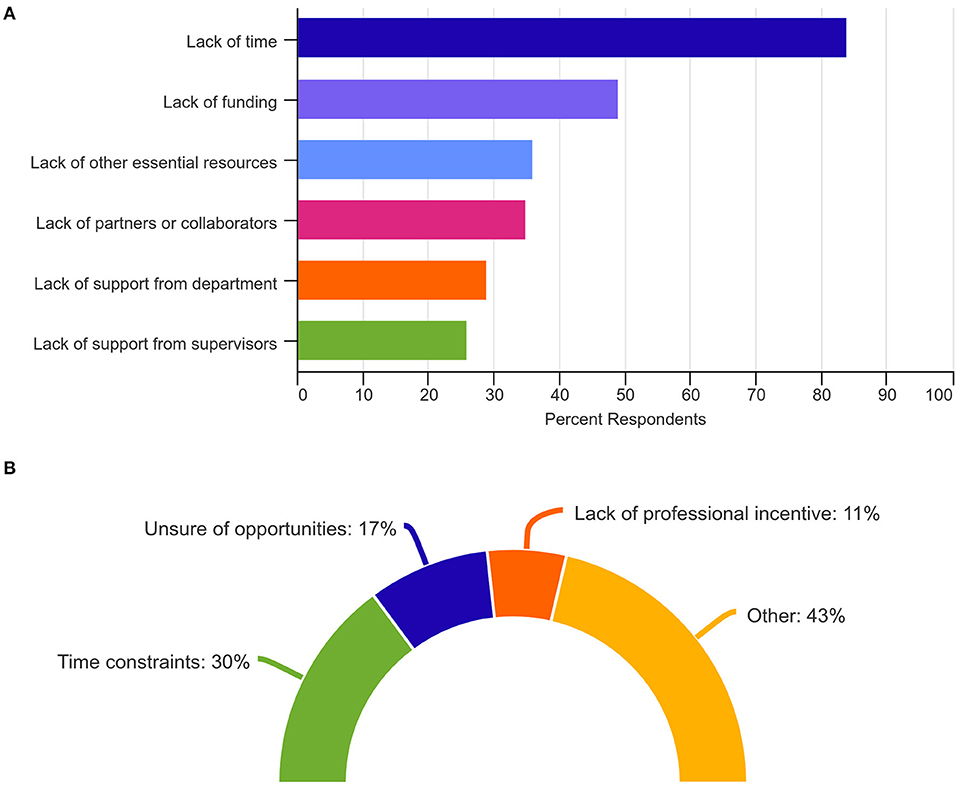
Figure 6. Barriers to respondents' participation in science outreach. (A) Percentage of respondents (n = 488) who indicated that they experience barriers which hinder their participation in science outreach. (B) Percentage of codes (n = 31) associated with respondents' qualitative responses to the question, “I do not participate in science outreach because…”.
Respondents who indicated that they never participated in science outreach (n = 42) were asked to complete the following free-response question: “I do not participate in science outreach because…” Thirty-one responses were coded by two of the authors (NCW and JG). Four codes emerged with a total of 47 instances (Figure 6B). Respondents cited time constraints as the top barrier to participating in outreach (30%, n = 14). One respondent noted that, “I've been too busy working in the lab to participate in many other activities, and science outreach isn't my number 1 priority for what to devote extra time to.” Another stated that, “There is already so much other work that needs to be done. Science outreach would just be one more thing to do without much [return on investment] for already stretched faculty and staff.” An additional major barrier was being unaware of opportunities to engage in outreach (17%, n = 8). “I have not been able to easily find opportunities that fit my schedule/available time, and that are easy to get to participate in, and that are within my comfort zone,” shared one responded. Lack of professional incentive was another concern shared by several respondents (11%, n = 5). As one respondent described, “It is not valued by the scientific community. That means it will not help me get a job after my postdoc. In such a hypercompetitive environment, how can I justify spending time on outreach when so much else gets piled on?” The remainder of the comments were categorized as “Other” and touched upon themes related to self-doubt [“I am shy and nervous about (participating)],” supervisor disapproval (“I think my advisor would want me to do more research instead of participating in outreach,”) and professional limitations (“It is not an available option with my position”).
Discussion
The final sentence of the seminal 1985 publication, “The public understanding of science: report of the Royal Society's ad hoc group” (colloquially referred to as the “Bodmer report”) issued one of the first broad clarion calls to the scientific community with respect to public engagement with science: “[O]ur most direct and urgent message must be to the scientists themselves: Learn to communicate with the public, be willing to do so and consider it your duty to do so” (Bodmer, 1985). Thirty-six years later, where are we with regard to the perception of science outreach among members of academic STEM communities?
Our study indicates that Bodmer's call to action has been strongly heeded. The members of the scientific community who we surveyed have an overwhelmingly positive view of science outreach, have received or would like to receive training, participate in large numbers in a variety of activities, and have high levels of comfort with their participation in outreach. Even more encouraging are the findings that participation in science outreach is overwhelmingly driven by an interest to showcase that science can be fun and full of wonder, and can help promote diversity, equity, inclusion, and access (DEIA) best practices – issues that also resonate with many target audiences for science outreach activities. In addition, there has been widespread acknowledgment that the “public” is not a monolith, but is rather a collection of many groups of connected individuals, in which scientists, too, belong (Dawson, 2018).
The outcomes of this research are in sync with the handful of similar studies from the past 20 years that have examined scientists' participation in, and attitudes toward, science outreach, though we recognize that the findings from this study may be limited by our relatively small, yet not insignificant, sample size (n = 530). Despite this limitation, our results suggesting that members of STEM communities hold highly positive attitudes toward outreach is echoed by studies from others (Poliakoff and Webb, 2007; Lisa and Russo, 2015; Rose et al., 2020). Similarly, our results demonstrate that fun and skill development are strong motivators for participating in outreach and align with results by Andrews and colleagues (Andrews et al., 2005). Our study is also consistent with the outcomes of work performed by Ecklund et al. and Johnson et al., who reported that women participate more than men in outreach (Ecklund et al., 2012; Johnson and Dieckmann, 2020). White women were highly represented in our respondent pool compared to other groups, which may reflect a demographic trend for the field of science outreach (YOUTUBE, 2021).
It is worth acknowledging that both the PI and Co-PI for this study are white women. We posit that the overrepresentation in responses from this group may be, to some extent, a reflection of homogeneity in the authors' academic and social networks—a situation known as homophily that is present across industries, including economics and science (McPherson et al., 2001; Currarini et al., 2009).
A strength of our work, in contrast to previous studies, is that we were able to gather responses from individuals from all different career stages and academic fields, which may provide a more comprehensive overview of how science outreach can be incorporated across academic contexts. Looking at constraints on participation in outreach, Andrews et a.l and Ecklund et al. report that a lack of time is one of the biggest barriers, though surprisingly the report from Poliakaff et al. did not find time to be a barrier (Andrews et al., 2005; Poliakoff and Webb, 2007; Ecklund et al., 2012). As with our study, Ecklund et al., Rose et al., and Andrews et al. all found that respondents felt outreach was not seen as being valued professionally (Andrews et al., 2005; Ecklund et al., 2012; Rose et al., 2020). Our study found that 50% of respondents would like to receive formal training in science outreach, confirming conclusions from Poliakaff et al. that providing training in this space would boost enthusiasm and overcome a major barrier to participation in science outreach activities (Poliakoff and Webb, 2007). Moreover, our data highlight key engagement of staff as drivers of science outreach in academic environments. More than 50% of staff surveyed here indicated that they participate in outreach with a high degree of frequency, which suggests that outreach roles are increasingly becoming a part of academic research infrastructure. Lastly, we recognize that our study is limited by potential survey order bias, whereby respondents may have altered their responses based on the order in which the questions were asked. This is particularly relevant for the open-ended, free response questions which followed multiple choice questions with prescribed responses.
The big picture
While the intentions driving these trends all appear to be moving in a positive direction with respect to attitudes toward and participation in public engagement with science, a larger question remains: has all of this energy, effort, expenditure of resources and change in mindset moved the needle at all in terms of what science outreach is actually trying to accomplish?
If we look beyond internal metrics and focus on external impact, we cannot confidently answer this question with an unqualified “yes.” Even though our study suggests that motivations for participation in science outreach are often centered on improving issues related to DEIA in STEM, it has been demonstrated that these efforts are reaching limited audiences, ones that are not reflective of the demographics of the American population (National Center for Science Engineering Statistics, 2020). Research has shown that popular science outreach activities such as public lectures, events held at science museums, science fairs and festivals, and K-12 classroom visits, all of which ostensibly align with our definition of science outreach (see Introduction), are unfortunately reinforcing rather than removing exclusionary barriers to participation in science (Dawson, 2014; Kennedy et al., 2018; Nielsen et al., 2019) and having minimal impact on perceptions toward, and understanding of, science (Ocobock and Hawley, 2020).
One explanation for these observations comes from the qualitative feedback we received from respondents as to why they participate in science outreach, which generally suggests a deficit-model, top-down approach to science communication and engagement. In spite of decades of social science research supposedly prompting an evolution in the description, cultivation and maintenance of relationships that scientists can develop with a variety of communities via science outreach (Bevan et al., 2020), this counterproductive approach, in which the representation of STEM to non-expert audiences is dictated by the dominant cultural norms of STEM, has remained in place. The resulting mindset and approach to science outreach serves to attract only those who are already familiar with these cultural norms, and reinforces much of the exclusive nature of science, particularly to marginalized communities who, throughout history, have been discouraged and actively prevented from engaging in scientific processes (Dawson, 2014, 2018).
Proposed solutions
When this evidence is considered in total, it is unsurprising that, among non-scientist audiences, there is diminishing respect toward, and trust in, science and the authority of scientists (Hamel et al., 2020), as well as a common viewpoint that science is relevant to the everyday issues at the forefront of public discourse (LabX, 2019). We must acknowledge that current efforts are still falling short of the ideals of science outreach as an approach to broadening awareness and understanding of, and participation in, science as a field.
Collectively addressing these outstanding issues requires a cultural shift, one that broadens efforts aimed at motivating academic scientists to participate in outreach activities to include a more intentional design and implementation of activities using best practices in the field. Perhaps one answer is to take a more holistic approach, one that considers not just the goals and outcomes we set for engagement, but also participatory motivations for all stakeholders—scientists and non-scientists alike.
We must align our efforts with those calling for inclusive science communication and engagement, an approach that demands more focus and attention be paid toward community-centric, bottom-up approaches to public outreach that tear down silos preventing collaboration and communication across various sectors and groups (Canfield et al., 2020). Such efforts must include principles and best practices around active listening, relationship building, and community organizing (Christens, 2010; Smith-Keiling et al., 2020). Universities, who are often at the industrial center of their respective geographic communities, in particular have an obligation to utilize this community-centric approach.
Within the scientific community, academic incentives need to be expanded to recognize the contributions of science outreach to the system as a whole. We cannot continue simply promoting the benefits of outreach and engagement within the scientific community without formal recognition being incorporated into the system. Funding agencies should follow the example set by the National Science Foundation in incorporating a Broader Impacts requirement for grant applications (National Science Foundation, 2022). Academic institutions should include public outreach as a criteria in their promotion and tenure decisions, and also consider the qualitative value of science outreach and engagement training for scientists. Through this study, we confirmed that many scientists are motivated to participate in outreach because they view science as fun and full of wonder, and have a desire to share these potentially powerful emotions with others. While it often feels taboo to make space for emotion in scientific environments, prompting “fun” emotions in science can actually enhance the likelihood that non-scientists will engage with science again in the future (Hadzigeorgiou, 2014; Gottlieb et al., 2018). This is particularly relevant when science outreach efforts are intended to serve minoritized communities (DeWitt and Archer, 2017).
Another straightforward step to be taken would focus on improving and expanding training in science communication and public engagement. As demonstrated by current crises, ranging from the COVID-19 pandemic to climate change to racial injustice, the scientific community writ large is still taking a deficit-model approach to communicating science in which audiences are passive recipients of information delivered using formal, top-down methods and outlets (Rubega et al., 2021). Clearly there is demand for science outreach training and opportunities, a welcomed trend that we hope continues to accelerate. Yet as we look forward, we argue that these offerings must be properly designed and distributed, in a manner that takes into account the best principles and practices of community engagement. Furthermore, there is a need for stakeholder collaboration on developing ways to examine and evaluate whether the trainings, activities and programs being implemented are actually achieving their stated aims (Seethaler et al., 2019).
Summary
Members of the academic STEM community are willing to participate in science outreach. Yet internal, external and systemic barriers have minimized, impeded, if not outright blocked, their ability to do so effectively. Only by embracing a mindset of inclusivity and accessibility and truly engaging with individuals and communities can the practitioners of science outreach achieve the lofty goals of improving DEIA, creating interest in STEM careers, and increasing awareness, understanding, and involvement with science. Despite improvements that have been made, none of us should be satisfied with the current state of affairs with regard to how science is practiced, taught and disseminated. We can, and must, do better.
Data availability statement
The raw data supporting the conclusions of this article will be made available by the authors, without undue reservation.
Ethics statement
The studies involving human participants were reviewed and approved by the Institutional Review Boards of the Rockefeller University and Northwestern University. Written informed consent for participation was not required for this study in accordance with the national legislation and the institutional requirements.
Author contributions
NW and JG: conceptualization, resources, software, formal analysis, supervision, funding acquisition, investigation, methodology, writing—original draft, and writing—review and editing. GH: formal analysis, writing—original draft, and writing—review and editing. LM: formal analysis, methodology, and writing—review and editing. All authors contributed to the article and approved the submitted version.
Funding
This work was supported by National Science Foundation Grant Award No. 1854018 to JG and NW.
Acknowledgments
The authors thank the following individuals who participated in the pilot survey. In addition, they thank all of the individuals who participated in this study.
Conflict of interest
Author GH was employed by American Society for Microbiology.
The remaining authors declare that the research was conducted in the absence of any commercial or financial relationships that could be construed as a potential conflict of interest.
Publisher's note
All claims expressed in this article are solely those of the authors and do not necessarily represent those of their affiliated organizations, or those of the publisher, the editors and the reviewers. Any product that may be evaluated in this article, or claim that may be made by its manufacturer, is not guaranteed or endorsed by the publisher.
Supplementary material
The Supplementary Material for this article can be found online at: https://www.frontiersin.org/articles/10.3389/fcomm.2022.907762/full#supplementary-material
References
Andrews, E., Weaver, A., Hanley, D., Shamatha, J., and Melton, G. (2005). Scientists and public outreach: participation, motivations, and impediments. J. Geosci. Educ. 53, 281–293. doi: 10.5408/1089-9995-53.3.281
Bernheim, R. G. (2022). Public Engagement in Emergency Preparedness and Response: Ethical Perspectives in Public Health Practice. Emergency Ethics. Oxford: Oxford University Press. Available online at: https://oxfordmedicine.com/view/10.1093./med/9780190270742.001.0001/med-9780190270742-chapter-5 (accessed July 21, 2022).
Bevan, B., Calabrese Barton, A., and Garibay, C. (2020). Broadening perspectives on broadening participation: professional learning tools for more expansive and equitable science communication. Front. Commun. 5, 52. doi: 10.3389/fcomm.2020.00052
Bhatia, R. (2020). Public engagement is key for containing COVID-19 pandemic. Indian J. Med. Res. 151, 118–120. doi: 10.4103/ijmr.IJMR_780_20
Bodmer, W. (1985). The Public Understanding of Science. London: The Royal Society. Available online at: https://royalsociety.org/topics-policy/publications/1985/public-understanding-science/
Canfield, K. N., Menezes, S., Matsuda, S. B., Moore, A., Mosley Austin, A. N., Dewsbury, B. M., et al. (2020). Science communication demands a critical approach that centers inclusion, equity, and intersectionality. Front. Commun. 5, 2. doi: 10.3389/fcomm.2020.00002
Caulfield, T., Bubela, T., Kimmelman, J., and Ravitsky, V. (2021). Let's do better: public representations of COVID-19 science. Facets 6, 403–423. doi: 10.1139/facets-2021-0018
Chan, E. Y. Y., Gobat, N., Dubois, C., Bedson, J., and de Almeida, J. R. (2021). Bottom-up citizen engagement for health emergency and disaster risk management: directions since COVID-19. Lancet 398, 194–196. doi: 10.1016/S0140-6736(21)01233-2
Christens, B. D. (2010). Public relationship building in grassroots community organizing: relational intervention for individual and systems change. J. Community Psychol. 38, 886–900. doi: 10.1002/jcop.20403
Currarini, S., Jackson, M. O., and Pin, P. (2009). An economic model of friendship: homophily, minorities, and segregation. Econometrica 77, 1003–1045. doi: 10.3982/ECTA7528
Dawson, E. (2014). “Not designed for us”: how science museums and science centers socially exclude low-income, minority ethnic groups. Sci. Educ. 98, 981–1008. doi: 10.1002/sce.21133
Dawson, E. (2018). Reimagining publics and (non) participation: exploring exclusion from science communication through the experiences of low-income, minority ethnic groups. Public Underst. Sci. 27, 772–786. doi: 10.1177/0963662517750072
DeWitt, J., and Archer, L. (2017). Participation in informal science learning experiences: the rich get richer? Int. J. Sci. Educ. B. 7, 356–373. doi: 10.1080/21548455.2017.1360531
Ecklund, E. H., James, S. A., and Lincoln, A. E. (2012). How academic biologists and physicists view science outreach. PLoS ONE 7, e36240. doi: 10.1371/journal.pone.0036240
Fiske, S. T., and Dupree, C. (2014). Gaining trust as well as respect in communicating to motivated audiences about science topics. Proc. Natl. Acad. Sci. U. S. A. 111(Suppl.4), 13593. doi: 10.1073/pnas.1317505111
Funk, C., and Hefferon, M. (2022). As the Need for Highly Trained Scientists Grows, a Look at Why People Choose These Careers. Pew Research Center. Available online at: https://www.pewresearch.org/fact-tank/2016/10/24/as-the-need-for-highly-trained-scientists-grows-a-look-at-why-people-choose-these-careers/ (accessed July 25, 2022).
Gall, A. J., Vollbrecht, P. J., and Tobias, T. (2020). Developing outreach events that impact underrepresented students: are we doing it right? Eur. J. Neurosci. 52, 3499–3506. doi: 10.1111/ejn.14719
Garbarino, J. (2020). Recommendations for the Continued Professionalization of Science Outreach within the Scientific Enterprise. The Rockefeller University. Available online at: http://rockedu.rockefeller.edu/new_outreach/professionalization
Gilmore, B., Ndejjo, R., Tchetchia, A., Claro, V., de Mago, E., Diallo, A. A., et al. (2020). Community engagement for COVID-19 prevention and control: a rapid evidence synthesis. BMJ Glob. Health. 5, e003188. doi: 10.1136/bmjgh-2020-003188
Gottlieb, S., Keltner, D., and Lombrozo, T. (2018). Awe as a scientific emotion. Cogn. Sci. 42, 2081–2094. doi: 10.1111/cogs.12648
Hadzigeorgiou, Y. (2014). “Reclaiming the value of wonder in science education,” in Wonder-Full Education: The Centrality of Wonder in Teaching and Learning Across the Curriculum, eds K. Egan, A. Cant, and G. Judson (New York, NY: Routledge), 40–66.
Hamel, L., Kearney, A., Kirzinger, A., Lopes, L., Muñana, C., Brodie, M., et al (2020). Top Issues in 2020 Election, The Role of Misinformation, and Views on A Potential Coronavirus Vaccine. KFF Health Tracking Poll - September 2020. Available online at: https://www.kff.org/coronavirus-covid-19/report/kff-health-tracking-poll-september-2020/
Johnson, B. B., and Dieckmann, N. F. (2020). Americans' views of scientists' motivations for scientific work. Public Underst. Sci. 29, 2–20. doi: 10.1177/0963662519880319
Johnson, D. R., Ecklund, E. H., and Lincoln, A. E. (2014). Narratives of science outreach in elite contexts of academic science. Sci. Commun. 36, 81–105. doi: 10.1177/1075547013499142
Kennedy, E. B., Jensen, E. A., and Verbeke, M. (2018). Preaching to the scientifically converted: evaluating inclusivity in science festival audiences. Int. J. Sci. Educ. B. 8, 14–21. doi: 10.1080/21548455.2017.1371356
LabX (2019). Science Out of the Box: Exploring Pathways to Relevance for the Millennial Generation. National Academy of Sciences. Available online at: https://labx.org/audience-research/ (accessed September 30, 2021).
Lacey, H. (1999). Is Science Value Free? Values and Scientific Understanding. Routledge & CRC Press. Available online at: https://www.routledge.com/Is-Science-Value-Free-Values-and-Scientific-Understanding/Lacey/p/book/9780415349031 (accessed July 25, 2022).
Lisa, D., and Russo, P. (2015). How Astronomers View Education and Public Outreach: An Exploratory Study. arXiv. Available online at: https://arxiv.org/abs/150708552 (accessed September 30, 2021).
Lopes, L. E., Waldis, S. J., Terrell, S. M., Lindgren, K. A., and Charkoudian, L. K. (2018). Vibrant symbiosis: achieving reciprocal science outreach through biological art. PLoS Biol. 16, e3000061. doi: 10.1371/journal.pbio.3000061
McPherson, M., Smith-Lovin, L., and Cook, J. M. (2001). Birds of a feather: homophily in social networks. Annu. Rev. Sociol. 27, 415–444. doi: 10.1146/annurev.soc.27.1.415
Michelle, C., Pooni, K., and Hartfree, Y. (2001). The Role of Scientists in Public Debate. London: The Wellcome Trust, 14.
National Center for Science Engineering Statistics (2020). The State of U.S. Science and Engineering 2020. NSF - National Science Foundation. Alexandria, VA: National Science Foundation. Available online at: https://ncses.nsf.gov/pubs/nsb20201/u-s-s-e-workforce#women-and-underrepresented-minorities (accessed September 30, 2021).
National Science Foundation (2022). Broader Impacts. NSF â National Science Foundation. Available online at: https://www.nsf.gov/od/oia/special/broaderimpacts/ (accessed July 25, 2022).
Nielsen, K., Gathings, M. J., and Peterman, K. (2019). New, not different: data-driven perspectives on science festival audiences. Sci. Commun. 41, 254–264. doi: 10.1177/1075547019832312
Ocobock, C., and Hawley, P. (2020). Science on tap: effective public engagement or preaching to the choir? J. Sci. Commun. 19, A04. doi: 10.22323/2.19010204
Pardini, R., Bertuol-Garcia, D., Demasi Araújo, B., Mesquita, J. P., Moraes Murer, B., do Carmo Pônzio, M., et al. (2021). COVID-19 pandemic as a learning path for grounding conservation policies in science. Perspect. Ecol. Conserv. 19, 109–114. doi: 10.1016/j.pecon.2021.02.009
Poliakoff, E., and Webb, T. L. (2007). What factors predict scientists' intentions to participate in public engagement of science activities? Sci. Commun. 29, 242–263. doi: 10.1177/1075547007308009
Rose, K. M., Markowitz, E. M., and Brossard, D. (2020). Scientists' incentives and attitudes toward public communication. Proc. Natl. Acad. Sci. U. S. A. 117, 1274–1276. doi: 10.1073/pnas.1916740117
Rubega, M. A., Burgio, K. R., MacDonald, A. A. M., Oeldorf-Hirsch, A., Capers, R. S., Wyss, R., et al. (2021).Assessment by audiences shows little effect of science communication training. Sci. Commun. 43, 139–169. doi: 10.1177/1075547020971639
Seethaler, S., Evans, J. H., Gere, C., and Rajagopalan, R. M. (2019). Science, values, and science communication: competencies for pushing beyond the deficit model. Sci. Commun. 41, 378–388. doi: 10.1177/1075547019847484
Smith-Keiling, B. L., Sharma, A., Fagbodun, S. M., Chahal, H. K., Singleton, K., Gopalakrishnan, H., et al. (2020). Starting the conversation: initial listening and identity approaches to community cultural wellness. J. Microbiol. Biol. Educ. 21, 21.1.33. doi: 10.1128/jmbe.v21i1.2073
The Wellcome Trust (2006). Survey of Factors Affecting Science Communication by Scientists and Engineers. London: The Royal Society, 46. Available online at: https://royalsociety.org/~/media/royal_society_content/policy/publications/2006/1111111395.pdf
YOUTUBE (2021). Who, What, Why of Science Communication: How Can We Make Sci Comm Education More Inclusive?. Available online at: https://www.youtube.com/watch?v=VdI9PE2DGII (accessed October 13, 2021).
Keywords: science outreach, public engagement with science, science communication, survey study, informal science education
Citation: Woitowich NC, Hunt GC, Muhammad LN and Garbarino J (2022) Assessing motivations and barriers to science outreach within academic science research settings: A mixed-methods survey. Front. Commun. 7:907762. doi: 10.3389/fcomm.2022.907762
Received: 26 April 2022; Accepted: 01 August 2022;
Published: 24 August 2022.
Edited by:
Merryn McKinnon, Australian National University, AustraliaReviewed by:
Andrew Jason Gall, Hope College, United StatesVeronica A. Segarra, Goucher College, United States
Copyright © 2022 Woitowich, Hunt, Muhammad and Garbarino. This is an open-access article distributed under the terms of the Creative Commons Attribution License (CC BY). The use, distribution or reproduction in other forums is permitted, provided the original author(s) and the copyright owner(s) are credited and that the original publication in this journal is cited, in accordance with accepted academic practice. No use, distribution or reproduction is permitted which does not comply with these terms.
*Correspondence: Jeanne Garbarino, amdhcmJhcmlub0Byb2NrZWZlbGxlci5lZHU=
 Nicole C. Woitowich
Nicole C. Woitowich Geoffrey C. Hunt
Geoffrey C. Hunt Lutfiyya N. Muhammad
Lutfiyya N. Muhammad Jeanne Garbarino
Jeanne Garbarino